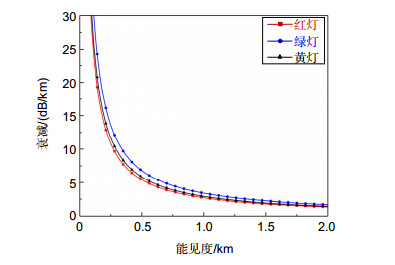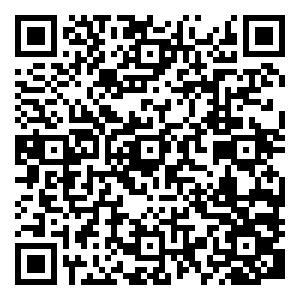-
摘要:
分析雾环境下利用LED交通灯进行车辆定位的性能,讨论了接收角度、道路宽度、雾环境下接收端信噪比等对车辆定位范围的影响。仿真结果表明:信号最佳接收角度为25°;车辆距离LED交通灯20 m之内时,道路宽度对信号的接收功率影响较大;在靠近交通灯处,车辆位于第二车道上的定位距离比车辆位于第一车道的定位距离少2.2 m;晚间接收端的信噪比优于白天,晚间的定位范围大于白天;与晴朗天气相比,雾天信噪比下降较大,将极大影响车辆的可定位范围,因此为保证安全驾驶,车辆在雾天行驶过程中需要更多的制动时间。
 Abstract:
Abstract:In order to analyze the performance of vehicle positioning using LED traffic lights in foggy environment, the influences of receiving angle, road width, and signal-to-noise ratio (SNR) at the receiver in foggy environment on vehicle positioning range are discussed. The simulation results show that the optimal signal reception angle is 25°; when the vehicle is within 20 m of the LED traffic light, the road width has a greater impact on the received power of the signal; near the traffic light, the positioning distance of the vehicle on the second lane is 2.2 m shorter than that of the vehicle in the first lane; the SNR of the receiver at night is better than during the day, and the positioning range at night is greater than during the day; compared with sunny weather, the SNR in the fog days decrease significantly, which will greatly affect the positioning range of the vehicle, so to ensure safe driving, vehicles need more braking time when driving in foggy days.
-
Key words:
- LED traffic light /
- visibility /
- signal to noise ratio /
- positioning range
-

Overview: The intelligent urban transportation system is an important direction for the development of urban road traffic in the future. It mainly uses the communication between transportation infrastructure and vehicles to build a safe, convenient and green intelligent information platform. Intelligent urban transportation system based on visible light communication has LED traffic lights and vehicle lighting. It can not only realize communication between infrastructure and vehicles, and between vehicles, but also obtain traffic road condition information in real time and accurately obtain vehicle position information. It is of great significance to carry out intelligent highway construction, promoting road network management and vehicle coordination. However, the outdoor atmospheric channel has a great influence on the intelligent urban transportation system based on visible light communication. A large amount of small water droplets or dust particles contained in the air will scatter or absorb the LED beam, causing loss of optical power. Many scholars at home and abroad are studying the communication performance of visible light in atmospheric channels, which lays a foundation for vehicle positioning using LED traffic lights. However, the positioning performance between outdoor LED traffic lights and vehicles in typical weather still needs further study. In this paper, the influence of fog on the vehicle positioning performance using visible light is studied. The influence of the receiving angle on the positioning range is analyzed, and the vertical angle is 45°, 55°, 65°. When the receiver receives a change in angle, the optimal receiving angle for the visible light is determined. By comparing the receiving power of the vehicle in different lanes, it can be seen that the road width has a great influence on the positioning performance within 20 m of traffic lights. The signal-to-noise ratio of the receiver at night is better than during the day under the same visibility. The positioning range of the vehicle at night can be greater than during the daytime. By comparing different concentrations of fog and sunny weather, it can be seen that fog has a greater influence on vehicle positioning based on visible light. Therefore, in order to ensure safe driving in the intelligent urban transportation system, the influence of the weather environment on the positioning distance should be considered when performing visible light vehicle positioning.
-

-
表 1 雾的等级与水平能见度的关系
Table 1. Relationship between fog level and horizontal visibility
等级 水平能见度/m 0(浓雾) < 50 1(大雾) 50~200 2(中雾) 200~500 3(轻雾) 500~1000 4(薄雾) 1000~2000 表 2 系统参数
Table 2. System parameters
参数 数值 LED波长/nm 525 LED功率半角/(°) 15 接收机最大视角/(°) 25 透镜折射率 1.7 光电感应面积/cm2 1 光电转换速率 0.35 平均发射功率/W 0.314 LED灯高度/m 5.5 发射角度/(°) 30 道路宽度/m 7 光电探测器高度/m 1 绿灯坐标 (0, 3, 5.5) -
[1] Dang Q H, Yoo M. Handover procedure and algorithm in vehicle to infrastructure visible light communication[J]. IEEE Access, 2017, 5: 26466-26475. doi: 10.1109/ACCESS.2017.2771199
[2] Komine T, Nakagawa M. Fundamental analysis for visible-light communication system using LED lights[J]. IEEE Transactions on Consumer Electronics, 2004, 50(1): 100-107. doi: 10.1109/TCE.2004.1277847
[3] 丁德强, 柯熙政, 李建勋. VLC系统的光源布局设计与仿真研究[J].光电工程, 2007, 34(1): 131-134. doi: 10.3969/j.issn.1003-501X.2007.01.030
Ding D Q, Ke X Z, Li J X. Design and simulation on the layout of lighting for VLC system[J]. Opto-Electronic Engineering, 2007, 34(1): 131-134. doi: 10.3969/j.issn.1003-501X.2007.01.030
[4] Zhuang Y, Hua L C, Qi L N, et al. A survey of positioning systems using visible LED lights[J]. IEEE Communications Surveys & Tutorials, 2018, 20(3): 1963-1988.
[5] 龙科军, 李峰, 高志波.雾天高速公路路况监测预警系统研究[J].交通科技, 2016(3): 183-186. doi: 10.3963/j.issn.1671-7570.2016.03.058
Long K J, Li F, Gao Z B. Study of foggy highway traffic monitoring and warning system[J]. Transportation Science & Technology, 2016(3): 183-186. doi: 10.3963/j.issn.1671-7570.2016.03.058
[6] 刘景龙.基于室外可见光LED交通灯的无线通信系统研究[D].哈尔滨: 哈尔滨工程大学, 2013: 1-65.
Liu J L. The analysis of outdoor wireless communication system based on the LED visible light[D]. Harbin: Harbin Engineering University, 2013: 1-65.
http://cdmd.cnki.com.cn/Article/CDMD-10217-1014131845.htm [7] Elamassie M, Karbalayghareh M, Miramirkhani F, et al. Effect of fog and rain on the performance of vehicular visible light communications[C]//Proceedings of the 2018 IEEE 87th Vehicular Technology Conference (VTC Spring), 2018: 1-6.
[8] 秦岭, 巨永锋, 杜永兴, 等.智能交通中新型可见光通信系统性能研究[J].公路交通科技, 2016, 33(7): 114-118. doi: 10.3969/j.issn.1002-0268.2016.07.018
Qin L, Ju Y F, Du Y X, et al. Study on performance of new visible light communication system in intelligent transport[J]. Journal of Highway and Transportation Research and Development, 2016, 33(7): 114-118. doi: 10.3969/j.issn.1002-0268.2016.07.018
[9] Kumar N, Alves L N, Aguiar R L. Design and analysis of the basic parameters for traffic information transmission using VLC[C]//Proceedings of the 2009 1st International Conference on Wireless Communication, Vehicular Technology, Information Theory and Aerospace & Electronic Systems Technology, 2009: 798-802.
[10] 曹岩, 雷涛.基于交通灯的高精度车辆定位技术[J].计算机工程与应用, 2015, 51(3): 212-215, 264. doi: 10.3778/j.issn.1002-8331.1406-0472
Cao Y, Lei T. High precision vehicle positioning method based on traffic light[J]. Computer Engineering and Applications, 2015, 51(3): 212-215, 264. doi: 10.3778/j.issn.1002-8331.1406-0472
[11] Chen Q R, Zheng W B, Zhang T, et al. A power analysis model for outdoor long-distance visible light communication[C]//Proceedings of the 2017 Ninth International Conference on Ubiquitous and Future Networks, 2017: 131-136.
[12] Kim Y H, Cahyadi W A, Chung Y H. Experimental demonstration of VLC-based vehicle-to-vehicle communications under fog conditions[J]. IEEE Photonics Journal, 2015, 7(6): 7905309.
[13] Akanegawa M, Tanaka Y, Nakagawa M. Basic study on traffic information system using LED traffic lights[J]. IEEE Transactions on Intelligent Transportation Systems, 2001, 2(4): 197-203. doi: 10.1109/6979.969365
-


 E-mail Alert
E-mail Alert RSS
RSS

 下载:
下载:








